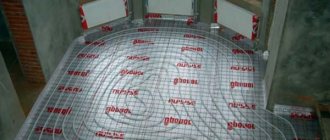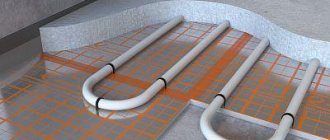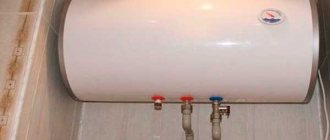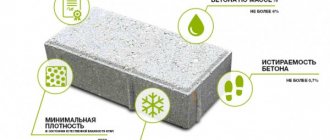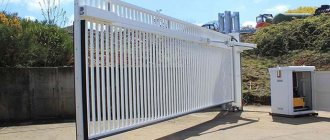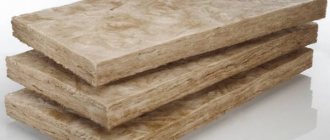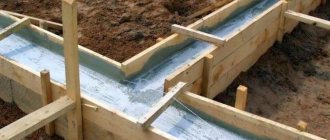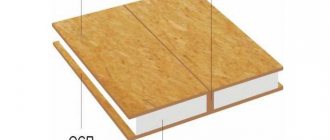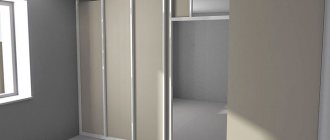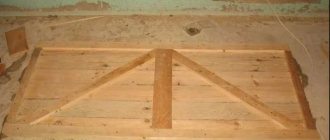Create comfort in your home and install electric "warm floor" It is quite possible to install tiles with your own hands, especially since for this you can choose several types of equipment that differ both in the installation method and in the operational characteristics.
But to ensure that the result does not disappoint, it is important, before starting work, to correctly calculate the power of the “warm floor”, prepare an accurate installation diagram and take into account the design features of the floor and the functional purpose of the room.
Laying heated floors under tiles
Types of electric “warm floors”
Installation of “warm floors” pursues several goals simultaneously. Most often, it plays the role of an additional heat source, especially in tandem with convection devices, for example, traditional radiators.
In this case, the heated warm air rises, and the space below the room remains cold. This is especially noticeable to residents of private cottages with unheated basements and owners of the first floors, but not only. A “warm floor” can become the only source, but in this case it is more rational to install a system with a water coolant.
Although for small rooms, electric varieties of “warm floors” are the best option: you can think about installing it, for example, during renovations in the bathroom.
Various equipment and materials are used to install heated electric floors; the only thing they have in common is that they use electricity to operate. So, an additional heat source can be created using:
- cable, the installation of which is carried out according to a pre-developed scheme, taking into account the characteristics of the room;
- heating mats made of fiberglass with cables laid in them;
- infrared heating elements mounted on a special film, which is why this “warm floor” is often called “film”.
Which type of “warm floors” to choose depends on many factors: objective and subjective; before making the final choice, you need to understand the main design and operational differences, as well as installation features.
Installation of electric heated floors under tiles. Video:
Pipe laying
Methods for laying pipes for a warm water floor.
Place aluminum foil or plastic film on the prepared surface.
A damper tape is glued along the entire perimeter of the room to a height of 15-20 cm, which will compensate for the thermal expansion of the screed with pipes.
A 3-5 cm layer of insulation is laid on top.
Expanded polystyrene, foam concrete or mineral wool can be used as thermal insulation material.
The more powerful the heated floor, the greater the thickness of this material should be.
Next, you need to consider the mounting for the pipes.
You can use one of two options:
- heat-insulating boards, which are fixed on special rails;
- reinforcement mesh to which the pipes will be tied with clamps.
Both methods are equally good and do not require additional surface preparation.
Plates and mesh can be laid directly on the insulation.
It is necessary to carefully consider the location of the heating circuit of the system, choosing one of two options: snake or spiral.
The second is more preferable, as it guarantees uniform heat distribution over the surface due to the alternation of return and supply pipes.
The pitch of the pipes can be different and range from 10 to 30 cm, depending on the purpose of the heated floor:
- if it is used as an additional heating system, the step is increased;
- if it is used as the main heating system, the step is reduced.
It is recommended to increase the frequency of installation along walls and windows.
If there are pieces of furniture in the room that will not be moved anywhere in the future, then there is no need to lay pipes under them.
Having laid the circuit, you need to secure its ends in the manifold and carry out pressure testing of the system.
It involves checking the heated floor for leaks and pressure losses.
A pressure gauge is installed on one side, and a pressure is created on the other side 1-2 atm above the working one.
If after a day the readings on the scale have not changed, you can continue working.
Otherwise, you will have to look for mistakes made.
It is necessary to prepare a concrete screed using cement grades M300 and higher.
There must be a coolant under operating pressure in the circuit at the time of filling the solution.
The layer thickness can be from 15 to 70 mm.
After 3-4 weeks, you can begin the last stage - finishing.
If the surface turns out to be smooth, then no additional preparatory work is required and you can immediately lay the tiles on the adhesive.
We recommend watching a video about installing a warm water floor with detailed comments.
Which “warm floor” is better to make under tiles: nuances of choice
If a cable is chosen for installation, then in this case it must be taken into account that it will be necessary to make a floor screed with an average thickness of 30-35 mm. This leads to a significant loss of ceiling height, as well as an increase in the load on the supporting structures of the house, which in some cases may be unacceptable.
And although this is the most affordable option in terms of price, additional costs will be required, quite significant, for the purchase of dry mixtures, components, etc. The labor intensity of the upcoming work should also be taken into account.
It is also particularly difficult to carry out calculations, primarily the length of the cable, which is determined not only by the area of the room, but also by the chosen laying scheme, which, in turn, is determined by the power of the required thermal radiation. When drawing up the diagram, the location of the furniture under which the cable cannot be laid is taken into account.
In the bathroom
As a rule, the cable is purchased according to length, and all other elements and parts are additionally purchased: thermostats, sensors, fasteners, etc., although there are ready-made kits designed for a certain area.
Thermal mats based on fiberglass are also a heating cable, only laid in the base, which greatly simplifies the installation process and calculations: only that part of the area that is not covered with furniture, especially heavy ones, is taken into account.
Their use is especially relevant in houses with wooden floors, since they can be installed in the subfloor structure - a screed is not necessary for them, but if it is done, its thickness is small. The greatest difficulty is making cable connections, which in this case is not a solid structure.
But, despite this, as well as the higher cost of 1 m2 of such a warm floor, it is very popular among owners of country houses and city apartments.
Infrared heated floor under tiles
Often, a film “warm floor” under tiles or other floor covering is chosen with the motivation that it is not a source of electromagnetic radiation.
In addition, its installation does not require a screed, but if it is laid under tiles, then for installation you should purchase special elastic adhesive mixtures for “warm floors”, which ensure good thermal conductivity and the absence of deformation processes under the influence of high temperatures.
In terms of cost, this is the most expensive “warm floor”, although it is very economical, so higher costs at the initial stage are compensated by lower energy consumption during operation.
Resistive and self-regulating cables for heated floors
When choosing a cable “warm floor” for tiles, the question will definitely arise about what type of wire to use for this: resistant or self-regulating.
The former produce the same amount of thermal power during operation, the latter, depending on the degree of their own heating, that is, the more they heat up, the less heat they produce. Because of this property, they are considered more fireproof.
Resistance cables come in single-core and double-core types, and the main difference between them is the connection method: to create a closed circuit, both ends of the single-core cables are connected to a power source.
First, one end is connected, for example, in the installation box, but before the thermostat. Laying is carried out according to the selected scheme, and then the circuit is closed with the second, “cold” end, which is also brought out into the installation box.
Installation of heated floors under tiles
The cables are connected using couplings that fit under the screed. The two-core resistant cable has a connection at one end, and a plug is installed at the other. The presence of a second current-carrying core ensures the circuit is closed.
The main disadvantage of resistant cables is that they generate a constant amount of heat, which, if difficult to dissipate, can damage the system. It should also be noted that two-core cables are more attractive both from an installation point of view and because their electromagnetic radiation is less intense.
Self-regulating cables do not overheat due to their original structure, which represents a special sequence of elements connected into a single chain, from which the wire cores are formed. Between them there is a polymer gasket, which acts as a heat conductor.
Unlike a resistant cable, a self-regulating cable does not have a constant resistance: it depends on temperature. The higher the temperature, the lower the resistance in the cable, and accordingly, the less heat is generated.
In terms of installation method, self-regulating cables do not differ significantly from resistant products, but their cost is much higher.
Step-by-step installation technology
Now let's look at how to properly make a warm floor under the tiles with your own hands.
Preparatory work
Preparing the premises and foundation includes the following steps:
- At the location where the temperature sensor is installed, a hole is made for the socket box using a hammer drill and a diamond bit.
- To lay the power cable from the switchboard, depending on the chosen installation method, grooves are cut or a cable channel is installed. For safety reasons, the thermostat should not be located in a damp room - it should be mounted through a partition in another room. To conveniently connect wires to the thermostat, it is best to install a deep socket box.
A socket for a socket box and a groove for a power wire. - You also need to make a groove and a hole in the wall in the bathroom to connect the heating cable and temperature sensor to the regulator.
Punching holes and grooves for laying the wire of the heat sensor and connecting the heating element to the thermostat.
Having completed all the preparatory work, we begin to prepare the foundation:
- Remove construction debris, repair large cracks, chips and other defects.
- If the difference in height is from 2 cm to 1 meter, the base is leveled with a thin cement screed or self-leveling mixture.
- Lay a layer of polystyrene foam boards with a thickness of 20 to 50 mm so that the heat does not escape into the floor slab (this point varies depending on conditions).
Laying the heat insulator on the base. - In wet rooms, the insulation is covered with a waterproofing film, after which a sand-cement screed is applied with a layer of 2–3 cm.
Screed thickness from 30 mm. - When the screed has dried (from 3 to 7 days depending on the room temperature), marking is done. The installation locations of all equipment and furniture are marked, and a distance is made from the walls and heating devices.
Applying markings to the prepared base.
One way to mark is to use colored tape, but a simple marker or construction pencil will also work.
In this case, waterproofing over the insulation is only needed to prevent liquid from the solution from leaking to the neighbors below and ruining their repairs. If you do not have neighbors, or they have not yet completed renovations, or you have reliably sealed all the cracks, then you don’t have to do waterproofing.
Laying the heating cable
Mounting strips, which are necessary for fixing the cable turns, are laid on the base and secured with self-tapping screws or dowels.
Installation of strips for cable fastening.
Before laying the heating cable, you need to ensure its integrity, for which you measure its resistance using a multimeter. If the obtained value falls within the range specified in the passport, the integrity of the cable is not compromised and it is suitable for installation.
Cable resistance measurement.
Then the cable is laid out in loops or a snake on the floor surface and fixed with bending tendrils on the mounting strip. The layout starts from the hole in the wall leading to the installation box, and the length of the cold end required for connection is estimated. To avoid the intersection of the cold end with the heating part, installation most often begins along the wall.
Note! Ready-made thermal mats on a mesh base are much easier to install: most often they have an adhesive backing, which makes it easy to fix the mats on any base. If turns are necessary, the mesh base is trimmed, and the cable is smoothly rotated at the desired angle, without twisting or kinking.
Having laid the cable, the cold end is inserted into the socket mounted for installing the thermostat, the ends of the wire are stripped and marked with the letters TP indicating the phases (N and L) for further connection.
The next step is installation of the temperature sensor, which is done in the following sequence:
- A corrugated pipe is laid from the socket box. Its free end is located between the turns of the heating cable at the same distance and is closed with a plug so that the solution does not get into it when pouring the screed.
- A temperature sensor is inserted into the pipe, the ends of the wire are stripped and marked (DT) for connection.
Important! After laying the heating cable, the resistance is re-measured to ensure there is no damage. If the values remain at the same level, proceed to the next stages of installing the heated floor.
Final stage
After the installation of the heating cable and temperature sensor is completed, the cable is covered with a self-leveling mixture intended for use in underfloor heating systems. The filling layer is such as to completely cover the cable, taking into account possible shrinkage of the screed. Laying tiles on a cement screed is carried out no earlier than after 3–7 days, and on a self-leveling mixture - according to the manufacturer’s recommendation.
Electrical connection
A power cable is laid along a pre-prepared groove from the distribution panel to the socket box. The cross-section of the wire being laid must be sufficient to withstand the connected load. In the installation box, the ends of the wire are stripped and marked with the letters N and L. The circuit breaker is selected based on the cable cross-section; usually a cable with a cross-section of 2.5 mm² and a 16A circuit breaker are used.
Note! If the heating cable has a screen, then a three-core cable is laid, the grounding conductor of which is connected to the screen of the heating element.
Connection to the thermostat is made according to the marking:
- The power wire cores are connected to terminals marked L and N, observing polarity.
- The heating cable cores are also connected in compliance with the markings and polarity: Ltp to terminal L1, and Ntp to terminal N1.
- The temperature sensor wires are connected to the corresponding terminals of the thermostat, designated SENSOR or the t°C symbol.
Having connected all the wires, the thermostat is installed in the socket box and secured with screws. At this point, the installation of the heated floor is considered complete.
Note! The heated floor is launched 28 days after the screed is poured. In this case, it is recommended to turn on the first time at a minimum power, with a gradual (once a day) increase in temperature by 5 °C.
Laying “warm floor” under tiles: advantages and installation
Ceramic tiles are a durable, hygienic and practical floor covering, which has one significant drawback: high thermal conductivity, which is why its surface always remains cold. But the installation of a “warm floor” allows this operational disadvantage to be turned into an advantage, since such a coating has no problems with heat transfer.
Therefore, if the “warm floor” in the room is the only source of heating, then the choice of tiles is optimal, since it will provide good conductivity for the generated heat even when using high-power cables.
“Warm floor” has important operational advantages, including:
- creating an optimal temperature regime due to the uniform distribution of heat throughout the entire room, including in its lower part;
- reliability and long service life;
- safety: the presence of electromagnetic radiation does not need to be proven, but its influence is not as dangerous as they say;
- the ability to precisely regulate the temperature, which allows you to create comfortable conditions, but with economical use of electricity.
“Warm floor” in the house is especially effective during the off-season, when there is no need to start the heating system, but the temperature in the house cannot be called comfortable.
Also, on cold winter days you can very quickly appreciate all the benefits of “warm floors”, which allow you to enjoy comfort in your home.
But for this, before choosing a “warm floor” for tiles or other covering, you need to correctly calculate its power. Of course, in this case it is better to use the help of specialists, but you also need to know the basic guidelines yourself.
How to choose a warm floor for tiles
The average power for rooms in the house is:
- bedroom – 100-120 kW/m2;
- children's room - 150 kW/m2;
- hallway, kitchen – 120-150 kW/m2;
- bathroom, toilet – 180 kW/m2;
- glazed loggia – 180-200 kW/m2.
Of course, these data are average values, but they are quite easy to navigate in order to calculate the power of the “warm floor”.
When calculating a “warm floor”, it is necessary to take into account what source of heating the room is: the main or additional one. The calculations also take into account the thermal conductivity of the insulation used, which can significantly affect the efficiency of the system and energy savings.
But some nuances of this type of heating should be taken into account, namely:
- increased load on the home’s electrical network, which must be able to cope with increased power;
- It is possible to install a “warm floor” only at the stage of renovation of the room, since installation involves certain general construction work, although their volume depends on the type of thermal element chosen.
It should also be taken into account that, although such structures are highly reliable and have a long service life, in the event of an emergency, replacing a failed element can turn into a full-fledged repair of the premises.
Thermal calculation
On average, to install a heated floor and create the most comfortable conditions in the premises, the average temperature of the coolant in it should be in the range from 45 to 55 degrees. If the finishing material is tile, then for a normal feeling it is enough to have a carrier temperature of 45 degrees.
If laminate is used as a covering, then it should be higher, since it is partially insulated by the board.
The underfloor heating system is calculated based on needs, and in general, it is considered flexible because the water supply can be adjusted to any temperature. Therefore, they are usually guided by general data: the temperature on the floor surface should be from 29 to 35 degrees.
Much is decided by the choice of method of laying pipes in the system, which is determined based on preferences for intensity and heating zones. If it is necessary for the heat to be evenly distributed throughout the room, then it is better to use the so-called snail.
With this laying scheme, the return alternates with the primary, so no strong differences will be felt.
Installation of “warm floor” under tiles: main stages
If you decide to install the “warm floor” yourself, then it is necessary to carry out a large amount of preliminary work. First, you should find out the condition of the base on which the cable or film will be laid: it must be smooth, without defects, cracks, etc.
If necessary, a thin leveling layer of the screed is poured with cement mortar or using special mixtures. The second option is more preferable from the point of view of the time factor.
Next, you need to carry out all the calculations on the power and amount of material, and draw up a laying diagram. When drawing up a cable laying diagram, the following requirements must be taken into account:
- minimum distance from the wall to the cable is 7-10 cm;
- the arrangement of turns and spirals must be maintained at a distance of at least 8 cm from each other;
- The cable turns must not intersect or overlap each other under any circumstances.
It is also necessary to determine the location for installing the mounting box: if the “warm floor” is installed in rooms with high humidity, then it should be mounted on the adjacent wall on the opposite side.
Cables are installed in the installation box, as well as the thermostat is installed, so free access to it must be provided for control. As a rule, it is installed at the bottom of the wall at approximately a height of 30 cm from the floor.
It is imperative to prepare for installation a corrugated pipe or special couplings in which the cable will be connected.
This may not be a necessary element, but if any problems arise, you will not need to repair the entire floor; it will be enough to get to the joints, so you should not neglect this.
Laying the heating cable
Before installing a cable for a heated floor, you need to check its resistance. It must match the parameters indicated on the stickers or documentation. The further sequence of actions is as follows:
- A special mounting tape is attached to the surface in increments of 50 cm to a meter. Fastening elements are located on it in 20 mm increments, which allows you to create the desired installation configuration. Instead of such tape, you can use a metal mesh; in this case, the cable is fixed using plastic clamps.
- The cable is laid in a snake pattern, maintaining the required distances from the walls. Do not allow some turns of the cable to touch others or cross them.
Laying the heating cable
Cable fixation
- A temperature sensor is placed at an equal distance from adjacent turns. It is wise to place it in a corrugated tube, the end of which should be carefully sealed to prevent solution from entering.
- Controls for heated floors are connected. If you are not sure of your qualifications, it is better to call a professional electrician. If you want to do everything yourself, follow the connection diagram indicated on the back wall of the rheostat or in the instructions.
- Using a tester, the resistance of the heating circuit is checked again. It should match the values obtained before installation.
- To check the functionality of the underfloor heating system, turn on the heating for a short period of time. One minute is enough. The indicators on the rheostat should light up and the cable will begin to heat up.
USEFUL INFORMATION: How to glue ceramic tiles to wood: different ways to prepare surfaces
Floor insulation
To direct heat flows upward in the room, you will need to insulate the floor, for which you can use insulation up to 4 mm thick; in addition, you can lay a foil covering to reflect heat waves.
If the work is carried out in a private house and we are not talking about a room above an unheated basement, then thermal insulation issues can be neglected, since all the heat produced will remain in the house, although it will spread in different directions. But in order to guarantee the required performance in a particular room, you cannot do without thermal insulation.
The best material for thermal insulation is penofol, equipped with a special self-adhesive layer and foil coating. Installation of insulation must be carried out with an overlap of 5-8 cm on the walls; after finishing the work, the excess is simply trimmed off with a painting knife.
A damper tape laid on top of the heat-insulating material along the perimeter of the wall will serve as a compensator when heated.
The cable can be laid directly on the insulation, but it is recommended to use a special metal mesh that prevents direct contact between them.
Possibilities of a water floor in an apartment
Heating is a decisive factor in the life of every person, especially if their apartment is on the ground floor, so the idea of installing water-based heating in their home often creeps into their heads.
But it will be quite difficult to implement this, and in many houses it will be completely impossible, because it will interfere with the normal operation of the hot water supply system.
It is prohibited to connect the floor heating system to a centralized system. In apartments with central heating, only electric heated floors are used, which is very practical and convenient.
As for the water type, its implementation is allowed only in houses with individual heating from a separate gas boiler. Moreover, to implement such solutions, you will have to take appropriate permission and carry out work under the supervision of specialists, since the system may depressurize and cause damage to property.
Water heated floors are most often installed in private houses for screeding, since they use an independent heating system from a gas or solid fuel boiler.
This is a great way to provide yourself with relatively inexpensive thermal energy. In addition, having such a floor heating system, you will protect yourself and your loved ones from unwanted colds and ailments, since it is hypothermic feet that are the main cause of such processes.


